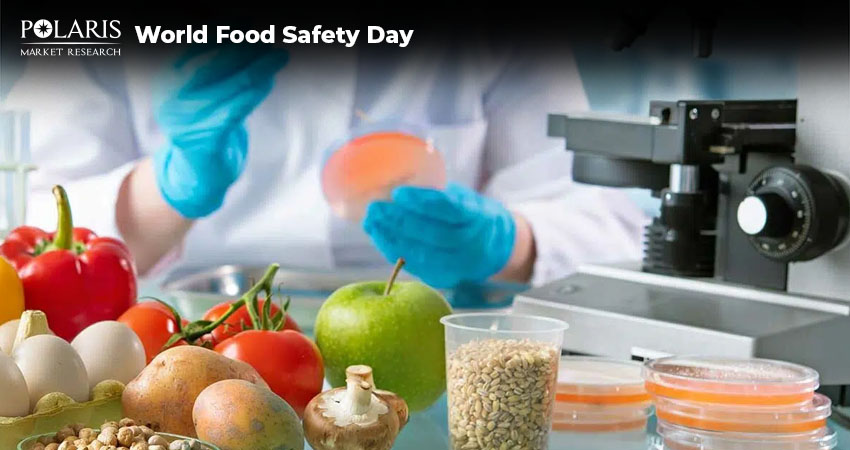Why Does Food Safety Matter Globally?

In today’s globalized world, food crosses continents before making its way to our tables. The interconnectedness presents incredible opportunities like access to diverse food products and year-round availability. But, at the same time, it poses significant risks such as foodborne illness outbreaks, regulatory inconsistencies, and supply chain vulnerability as well.
Food safety challenges can start in one corner of the world and quickly affect people thousands of miles away. As such, protecting food safety is a global and local imperative, requiring collaboration across various entities to keep the food supply secure, healthy, and reliable.
In this blog post, we explain to you the fundamentals of food safety. Also, we shed light on how advanced technologies and initiatives like World Food Safety Day are raising awareness, driving innovation, and reinforcing the collective responsibility needed to ensure the food we eat remains safe.
The Fundamentals of Food Safety
Food safety encompasses all the practices and conditions needed to ensure food is safe for consumption and free from contaminants that can cause illness or injury. While this may seem straightforward, maintaining food safety is complex in reality. As a multi-layered process, food safety involves careful control and monitoring at every stage of the food chain.
Food can be contaminated by a variety of hazards, including:
- Microbiological Hazards: Microbial hazards include bacteria, viruses, parasites, and molds. These pathogens can cause foodborne illnesses ranging from mild gastrointestinal discomfort to severe, life-threatening conditions.
- Chemical Contaminants: Chemical contaminants can enter food through pesticide residues, veterinary drug residues, heavy metals like lead or mercury, food additives, or environmental pollutants. Long-term exposure to these contaminants can lead to chronic health issues.
- Physical hazards: The accidental introduction of foreign objects like glass shards, metal fragments, plastic pieces, or stones during agricultural processes can cause injury or contamination.
Key Stages in Ensuring Food Safety
Food safety must be carefully managed throughout the entire supply chain to minimize risks and protect consumers. This involves critical control steps at various stages:
Primary Production: The first step starts at the farm or site of origin. Here, the implementation of safe agricultural practices is essential. This includes using clean and safe water for irrigation, ensuring soil health, and properly using agrochemicals to prevent residues.
Processing and Packaging: After harvesting, food often undergoes processing to transform it into packaged food and consumer-ready products. This phase requires stringent hygiene protocols within facilities, including regular sanitation of surfaces, equipment, and employee hygiene practices to prevent cross-contamination.
Storage and Transport: Maintaining proper storage conditions is crucial for inhibiting microbial growth and preserving food quality. This often translates to controlling temperature and humidity. Maintaining the integrity of packaging throughout transport is also essential.
Retail and Consumer Handling: Clear and accurate labeling, including expiration dates, storage instructions, and allergen information, allows consumers to make safe choices. Proper food storage, cooking, and hygiene practices at home reduce the risk of foodborne illnesses.
Why World Food Safety Day Matters?
The World Food Safety Day is celebrated annually on June 7. It was established by the United Nations General Assembly in December 2018 and led by the World Health Organization (WHO) and Food and Agriculture Organization (FAO). The day emphasizes the need for sustained commitment to preventing, detecting, and managing foodborne illnesses.
The 2025 theme, “Food safety: science in action,” emphasizes the critical role of scientific knowledge in ensuring safe food. It highlights how scientific evidence fuels progress in food safety, from expert advice and surveillance to global collaboration. It also highlights the importance of putting scientific knowledge into practice, emphasizing that food can only be safe if guidance and advice are acted upon.
Role of Technology in Ensuring Safer Food
As food systems grow increasingly complex, technology has emerged as a powerful enabler in enhancing food safety. Here’s how some of the most prominent technologies are transforming the food landscape:
Blockchain and Digital Traceability: Blockchain technology allows every stage of a food item’s journey to be recorded on a secure, tamper-proof ledger. This digital transparency enhances trust and allows for faster and more precise product recalls during contamination events.
Smart Packaging: Packaging is also undergoing a significant evolution. Innovations such as time-temperature indicators, gas sensors, freshness monitors, and tamper-evident seals are allowing producers and consumers to assess product integrity. These features can even alert handlers if frozen food has been stored at unsafe temperatures or if it’s past peak freshness.
Rapid Pathogen Detection: Traditional sensors often take days or even hours to identify harmful pathogens. Today, biosensors, portable labs, and molecular diagnostic tools can detect bacteria within minutes or hours. Along with labs, these technologies are also being deployed in food processing facilities and retail environments before products even reach consumers.
IoT and Remote Monitoring: The Internet of Things (IoT) is being used to monitor critical parameters such as temperature, humidity, hygiene levels, and the concentration of food preservatives in real time. These systems can automatically trigger alerts when conditions fall outside safe ranges, allowing for swift efforts that reduce spoilage and contamination risks.
The Road Ahead
Food safety isn’t a static goal. It’s a continuous journey that evolves with new science, new threats, and new expectations. Food safety involves vigilant monitoring, robust infrastructure, and an empowered public. Initiatives like World Food Safety Day serve as a reminder for us to support food safety technologies, strengthen global cooperation, and promote transparency and traceability with every step.

